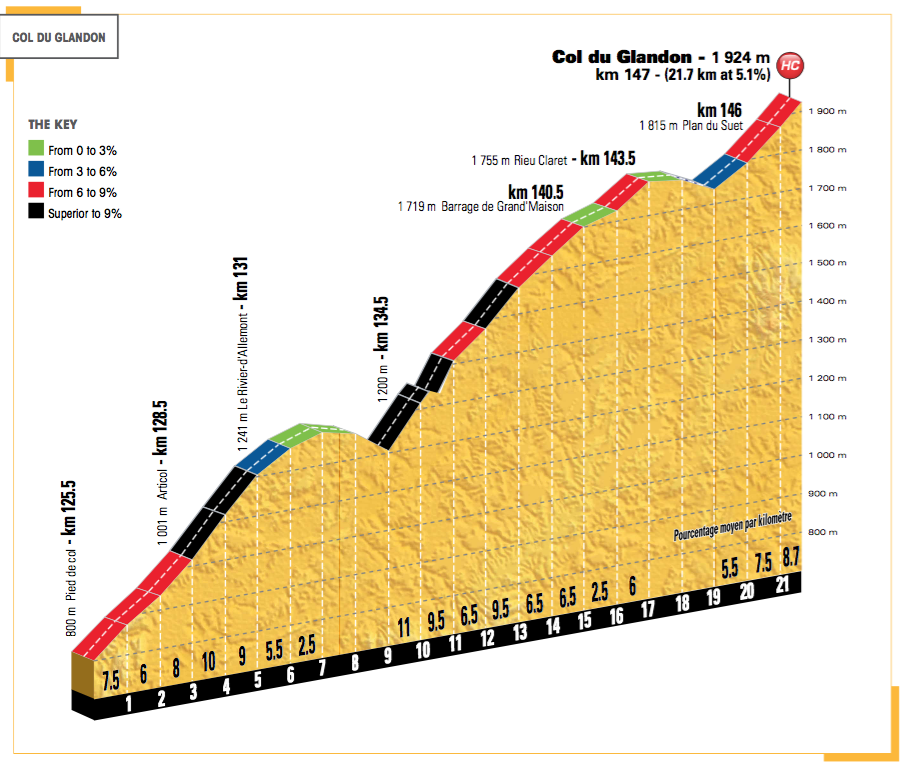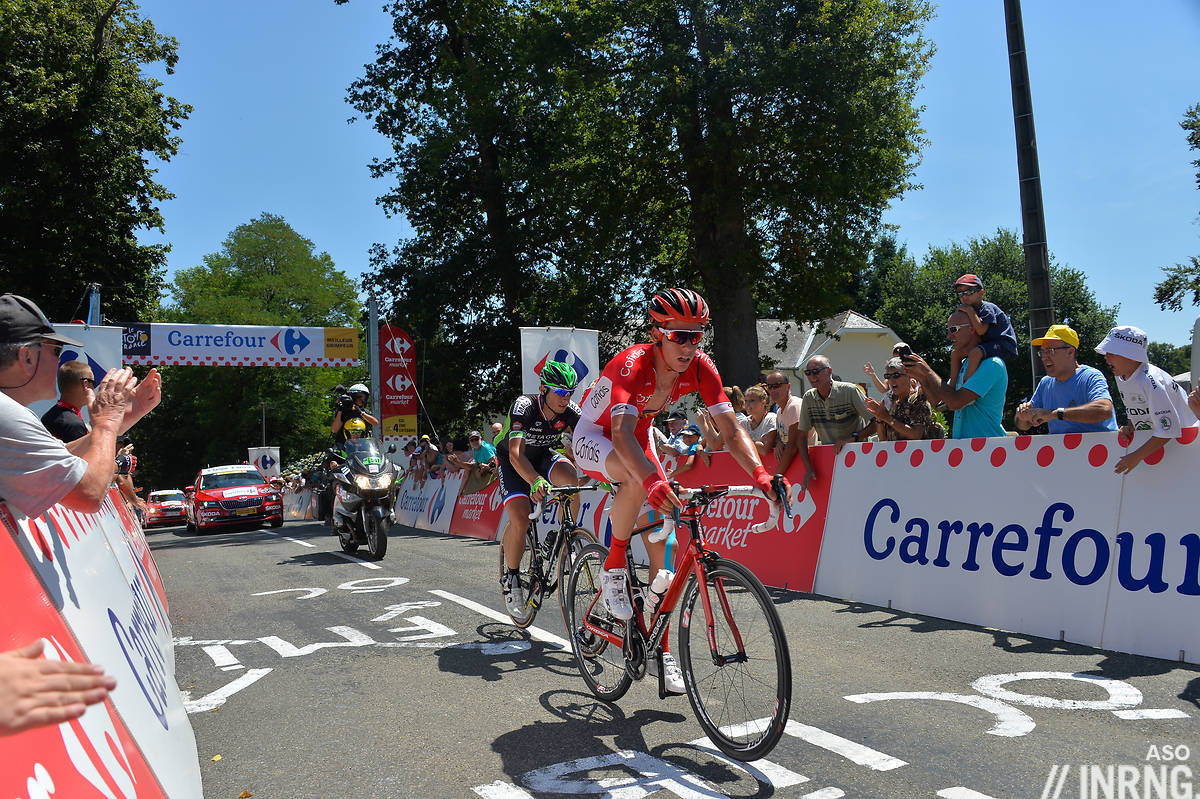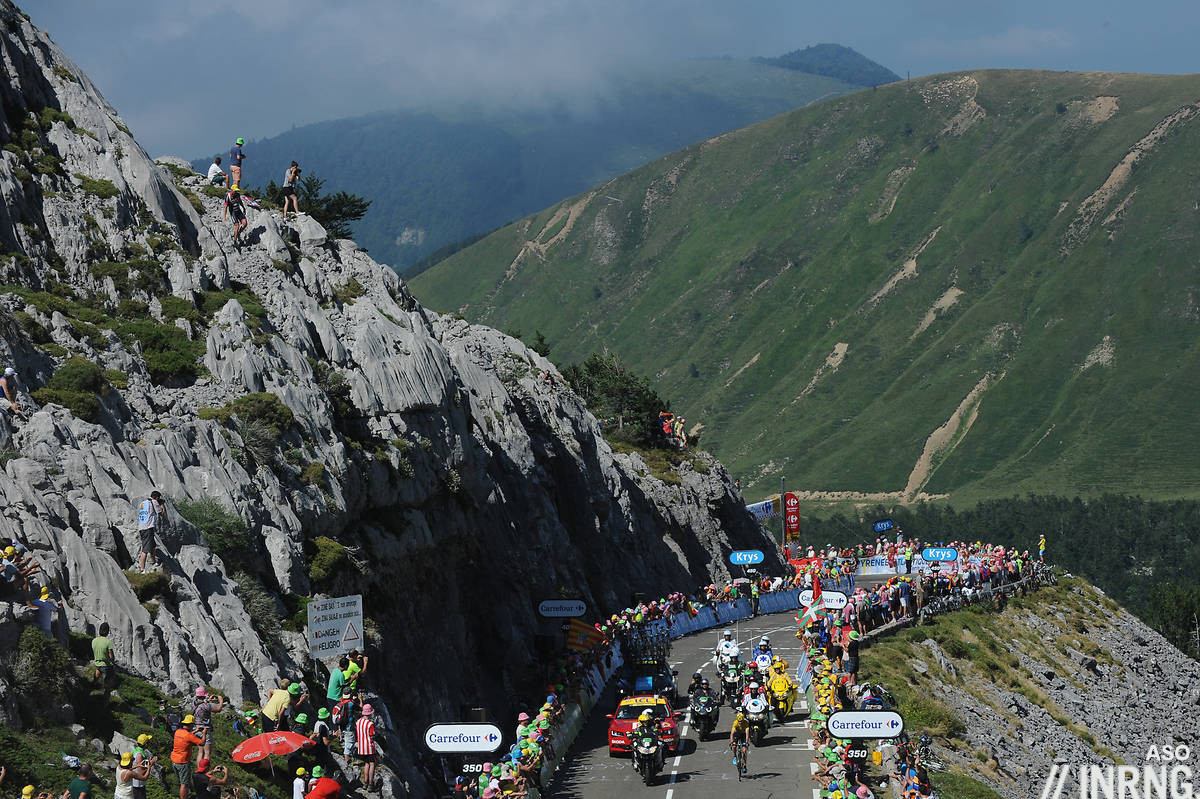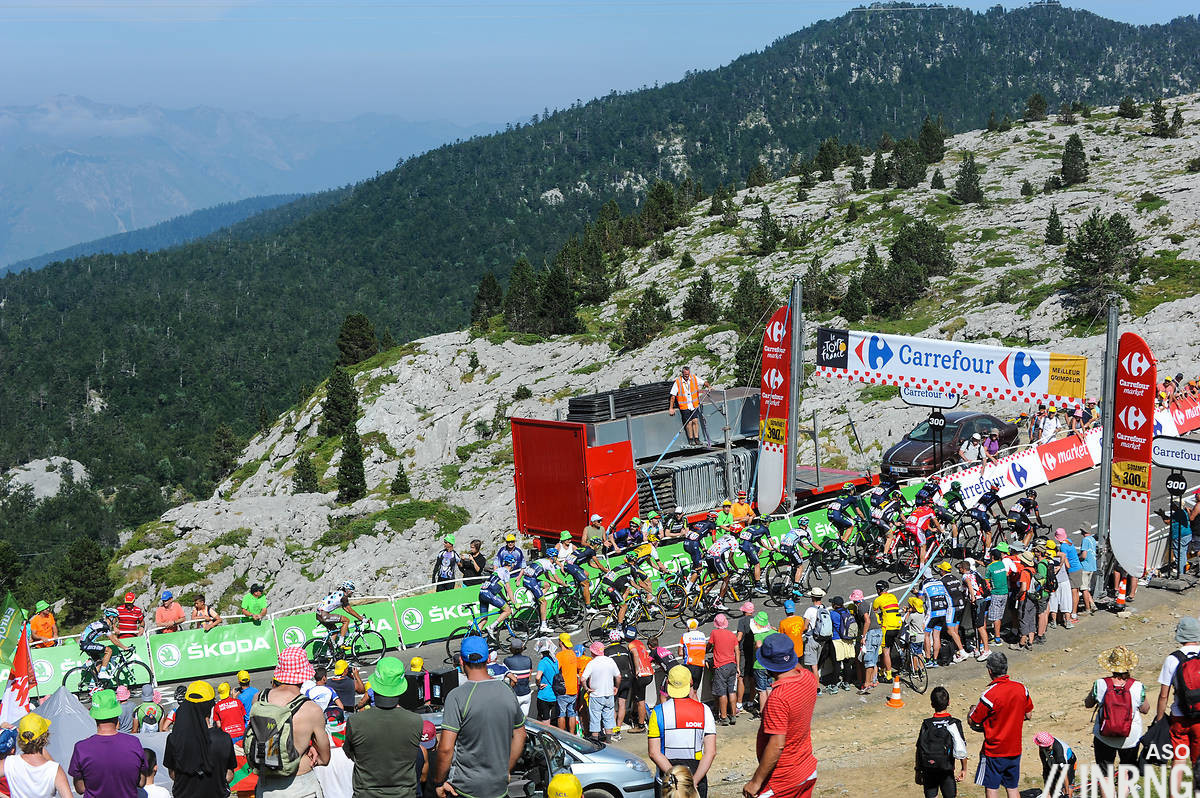The Tour de France tackles the hors catégorie Col du Tourmalet today for the 81st time. The race rates climbs with five labels, from 4th category for the easiest to 1st category and then HC for hors catégorie, “beyond categorisation”. A frequently asked question is how are these categories determined. Here’s the answer…
The categories serve two purposes:
- To illustrate the difficulty of the climb for the riders media and spectators
- To allocate points for the mountains competition
These ratings are set by the Tour de France and not by any mapping company or military survey. There is a formula to classify the climbs where you take the square of the slope’s % gradient and multiply it by the length in kilometres to get a score:
%2 x km
At the risk of reading like a school maths book here are some examples:
- The HC-rated 17.1km Col du Tourmalet sits at 2,115m above sea level and starts at 860m, a slope of 7.3%. That’s 7.32 x 17.1 = 911
- Tomorrow’s Plateau de Beille summit finish, also HC-rated, is 7.9% and 15.8km long = 986
- The highest score in the race this year is the Col de la Croix de Fer, 6.9% for 22.4km = 1066
- The south side of the Col du Glandon, used on Stage 18, is HC-rated and 5.1% from 21.7km = 564
- Next week’s summit finish at La Toussuire is a 1st category climb and with 6.1% for 18km scores 670
- Alpe d’Huez is 8.1% for 13.8km = 905
So how come the Glandon scores 564 yet is HC-rated compared to the 1st category La Toussuire which scores 670 ? It’s because the average gradient doesn’t tell us everything. Look at the profile for the Glandon’s south side:

The Glandon’s got two downhill sections, each roughly two kilometres long and these reduce the mean average slope. For the cyclist the mode gradient is roughly 7% for 17km which makes it harder than La Toussuire, is 6.1% for 18km.
The formula is used for information not definition. You know an HC climb when you see it and you can work backwards to rate a first category climb. The more arbitrary definitions go to the smaller climbs where sometimes a tiny rise in the road is labelled as a climb to spice up a stage and ensure the mountains competition sponsors get some value for their spend. Sometimes the race owners just want to enliven part of the stage and tilt the incentives.

“These go to HC”
Humans have discovered distant planets and classified hundreds of thousands of species of animals but there are some climbs that are apparently beyond categorisation. Rather than having climbs rated from 1st to 5th category, we have the hors catégorie label, as in “beyond classification” presumably because it sounds better, a dash of mystery and adventure.
The Tourmalet has been climbed for over 100 years, long before the category system arrived. So HC label has a touch of the Spinal Tap hype but all the same these are exceptional roads.
Summary
There is a formula but there is no fixed rule. The categories are applied according to common sense to help distinguish a climb’s value, a rating of the difficulty but also its strategic importance.



A footnote for loyal readers to say the above is a reworking of old piece with more to explain the importance of formula and to score this year’s climbs.
You could also mention that if a climb comes later in the stage it is more likely to be awarded a higher category.
Does it mean that the categorisation evolves ?
A HC one year, Cat. 1 the next year ?
That’s surprising !
Ride the same climb just after warming up or after some 150 km and say 4,000 mts of previous ascents and I’d find it surprising if you don’t notice any *evolution* 😉
I still prefer the urban legend that climbs are rated according to what gear Citroen 2CV uses to climb them. HC would mean unreachable with a 2CV.
+1 Love this!
+2.
Haha.
That can’t be right – nothing stops a 2CV!
Nothing!
except warm weather, cool weather, rust, oil starvation, a freeway overpass, crying baby…
I have read and heard that urban myth as well.
Until disproved, I am sticking with the story : )
Far more romantic approach than the algebraic equation stated above.
bob roll told this story today during the broadcast so it must be true 🙂
I was in a place I could watch the video feed as packaged in the U.S. and cringed when I watched it. Ugh. I’d be angry if I paid for that content.
The NBC coverage is abominable.
Let’s just take a steep road, like La Bastille in Grenoble (1.8 km @ 15%). If your 2CV stalls before the top, should the climb be rated HC? Definitely not! 🙂
Same goes for the easy side of Galibier (22 km @ 5.2 % from le Monêtier), a 2CV can easily get to the top in 2nd gear. But it’s not a Cat. 2 climb, it was a Cat. 1 before becoming the first HC in history in 1979.
It’s of course a myth but it’s always funny to hear. 🙂
In fairness, La Bastille climb is almost worth a HC – or at least it feels like it does when you get to the second corner 🙂
hehe, the 2CV rule works for me, from bitter experience!
I should also note that I drive a 2CV. Have done so since I was 16, 22 years. Travelled over 30 countries with it, plenty of mountains too, and have still to encounter a mountain that it will not climb.
My parents H van on the other hand…
There’s also been some inflation in the categorization of climbs in the Tour. I guess if Chourchevel was used again, it’d be HC.
As for your formula, @Linkinitouille has made a very nice graph with the climbs used between 2008 and 2014: http://i.imgur.com/uSNlSEs.png
What are those two crazy 11% average gradients of around a 1km length, is that the two Murs that were used this year ?
Hey, thanks for the shoutout! I’ve actually posted this graph in the comments of the previous version of the article, which said there wasn’t any rules about categorization – even though this graph shows there’s a correlation. Actually, Thierry Gouvenou confirmed it in an interview that they based the categories mostly on the squared gradient criterion with some adjustments leading to a higher or lower category.
For example, let’s just take Cauterets this year. It’s 6 km @ 5.3%, and is rightfully a Cat. 3 climb. But “strangely”, the GPM was placed 3.5 km before the finish line. It’s actually a trick by ASO to not count Cauterets as a MTF – if they placed the GPM at the finish, the climb would be 10 km @ 4.2%, which would likely become a Cat. 2, and therefore a MTF. And it would be worth 10 points (counting the double) instead of 2.
On the other end of the spectrum, we have the Col des Chevrères from last year. It’s a harsh and steep climb, but very short – 3.5 km @ 9.5%. It was rated Cat. 1 by the organizers. But if you look the Portet d’Aspet (west side), it’s a 4.4 km @ 9.6% climb! It’s longer and steeper – but it always was a Cat. 2, and still is. Chevrères probably had an advantage that it had a very steep 18% section in the middle of the climb and it was placed right before the finish at La Planche des Belles Filles in a stage already full of tough climbs. Prudhomme considered it was the hardest medium mountain stage ever designed.
The problem with “overrating” climbs is it creates some coherence problems. As we can see, we have a Cat. 2 climb which is harder than a Cat. 1. Also, if we only take the category as a difficulty indicator, Chevrères would be as hard as the col de Menté (9.3 km @ 9.1 %), La Toussuire (18 km @ 6.1%), Cormet de Roselend (20 km @ 6 %), Courchevel (22 km @ 6.5 % – definitely the hardest Cat. 1 climb ever since the introduction of HC) and Port d’Envalira (35 km @ 4.8 %).
Categorizing climbs has a side effect, it can put two very different climbs into the same difficulty value when it’s not the case, especially when there’s overrating and underrating.
We can also take another examples: the Col de Parménie in 2008 (5.3 km @ 7%) was rated Cat. 3. By the calculations, it’s technically a Cat. 2. In 2013, the col de l’Épine (6.1 km @ 7.3%) was a Cat. 1 climb! And there were other discrepancies in history – the well-known Soulor-Aubisque combo, in both sides, shown some nice stuff, like Soulor being a Cat. 2 while descending Aubisque, or Soulor being a Cat. 1 then having Aubisque as another Cat.1. Nowadays Soulor is only categorized when it’s passed alone, and Aubisque is considered as one HC climb whatever the side it’s being tackled on.
I could say there are some “errors” in the recent system but in the old times there were quite powerful mistakes, like La Ruchère en Chartreuse being HC in 1984, or the only appearance of the Mont du Chat in the Tour de France (8 km @ 11%) being only a Cat. 2 climb in 1974. It was put on the same level as the Col de la Sentinelle (5.5 km @ 5%). Yep. And everybody in the peloton was surprised about the difficulty of this Cat. 2. Including Merckx who lost a minute to Poulidor (before catching up in the descente), who knew the climb thanks to the Dauphiné in 1966.
Categorization will always lead to an egg being in a wrong basket – but it’s much better nowadays than decades ago. 🙂
Many thanks for this, very informative.
I await the Mont du Chat’s return in the Tour or Dauphiné some day.
I think every cycling fan is expecting the Mont du Chat to return. After all it’s one of the toughest climbs France has to offer.
Very interesting, love the passion behind all those numbers and @&%signs.
The Spinal tap link must be watched by all.
I am chagrined to admit that I knew exactly what Spinal Tap reference it was before following the link.
Well played, Inrng!
“mean”, “mode”….this is why we come to INRNG.
typo – There is a formula but there is *no* fixed rule
Will we ever see a “pure climber” win the dots again?
Majka last year? Quintana in 2013 was defiantly a “pure Climber” winning polka dots
They had to win stages to earn the double points bonification.
Bonification doesn’t read or sound the same unless it’s said in an Irish accent.
🙂
Bonification
Calculayshun
Majerlee sufferin
God bless Sean Kelly.
Watching Paris-Nice a couple of years ago, I was convinced that Kelley was obsessed with the effects of temperature on rider performance, as he kept asking how they would perform on ‘cold days’.
Still, with the skewed points system, we probably will never see the likes of a Moncoutie or a Voekler earn the polka dot jersey.
Voeckler won it in 2012
I wouldn’t call Voekler a pure climber either, he can climb well, but he’s not a pure climber.
Very helpful! Thanks!
Love yr analysis and read you daily, but “Its difficulty” not “it’s.” It’s means “it is.”
Is dauphiné classification different because Modane Valfréjus was 8.4k at 5.8 percent (1st cat) if I remember and 2nd cat climb in stage 14 this year is 9 k at 6 percent?
Yes, they have only 1-2-3 categories.
Actually they have the same categories – HC-1-2-3-4. Look at the 2014 edition for an example. Paris-Nice only has 1-2-3 (don’t recall any HC climb in PN).
However, the categories are usually easier in Dauphiné. Valfréjus would be likely a Cat. 2 in the Tour. But when they are repeating a stage or a climb from the upcoming Tour, they tend to keep the same category between the two (just look at the Pra Loup stage as a reference).
Ranking is also relative to where the climb lies in the stage. Early on a borderline cat 1/HC climb is a cat 1. At the end of the stage it gets an HC.
That’s not exactly true. As an example Courchevel (22 km @ 6.5%) and La Toussuire (18 km @ 6.1% – there are harder sides) are both MTFs, and are worthy of the HC ranking. But they are still Cat. 1 climbs. On the other hand, climbs like Pla d’Adet (10.2 km @ 8.3%) or Arcalis (11 km @ 7 %) are rated HC.
I have no doubt that Courchevel these days would be HC but La Toussuire seems to stay one of the hardest Cat. 1 climbs ever.
Slightly off-topic, but since you mention the Tourmalet a few times in your piece, why is it – do you think – that such a nasty climb hasn’t been very decisive in recent years? In my experience, it is one of the harder climbs that the Tour uses. Is it where it is positioned in the race overall or where it sits within a stage (ie not a summit finish)? It feels as though the race missed a trick today in that if the stage had finished at the bottom of the descent, perhaps the race up the Tourmalet would have been different?
No doubt. I think Inrng alluded to that possibility recently.
Tourmalet had a bit if a gents’ agreement to it today, perhaps. Or abject resignation.
Hope tomorrow someone wakes up with great legs and a big heart.
Said from armchair with beer in hand.
It is a hard climb and as we saw yesterday it still thinned down the peloton to a very select yellow jersey group. As you say it’s just often far from the stage finish.
The only way to valorize the Tourmalet would be:
– Finishing at the top (like in 2010)
– Finishing on the slopes like Super Barèges or La Mongie
– Finishing either at Luz-Saint-Sauveur, Bagnères-de-Bigorre or Lac de Payolle.
It’s definitely a mythical climb but modern cycling and its way to delay the leaders’ attack at the latest moment possible basically killed the decisive factor of the Tourmalet.
Ranking problems are part of a surprisingly rich branch of applied mathematics called operational research. The categorisation of climbs is technically a ‘multicriteria problem’. If ASO ever gets serious about consistency, they may hire a mathematician…
What we tend to forget is that the climbs themselves have changed over the years, never mind the categorization. In earlier years some of the climbs were unsurfaced and little better than Goat tracks.
Those same climbs today are smooth Tarmac.